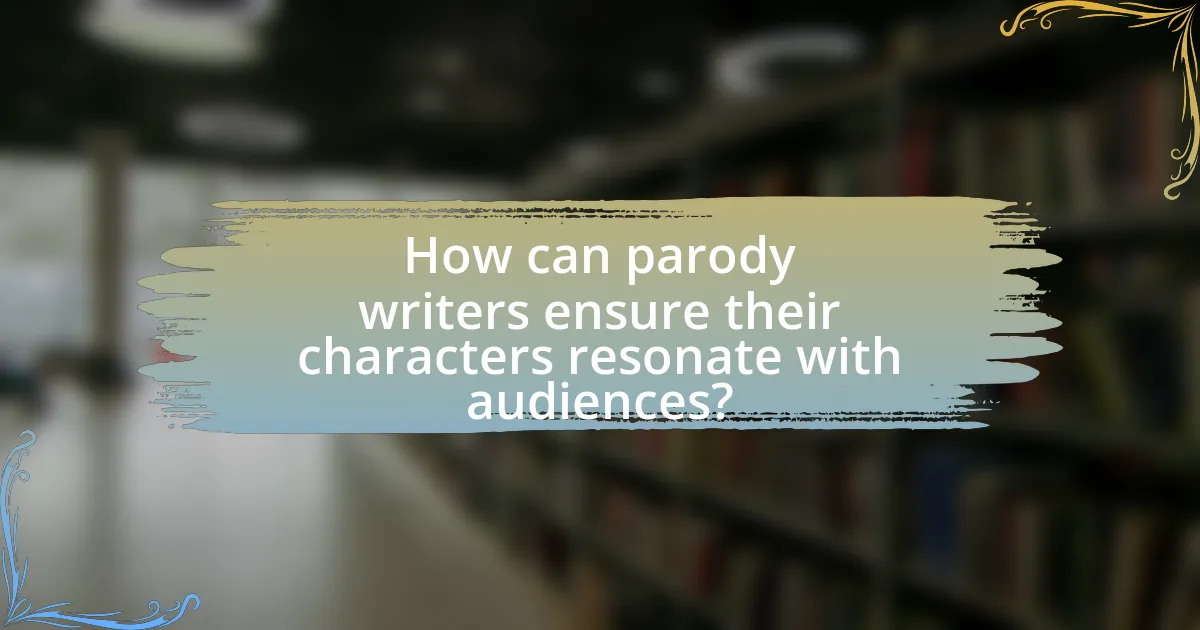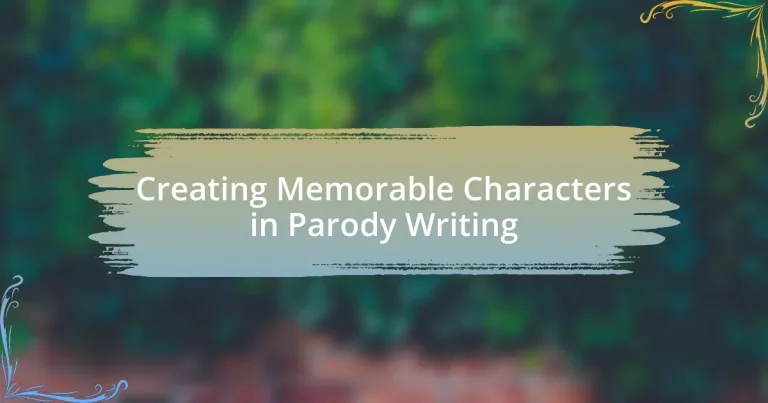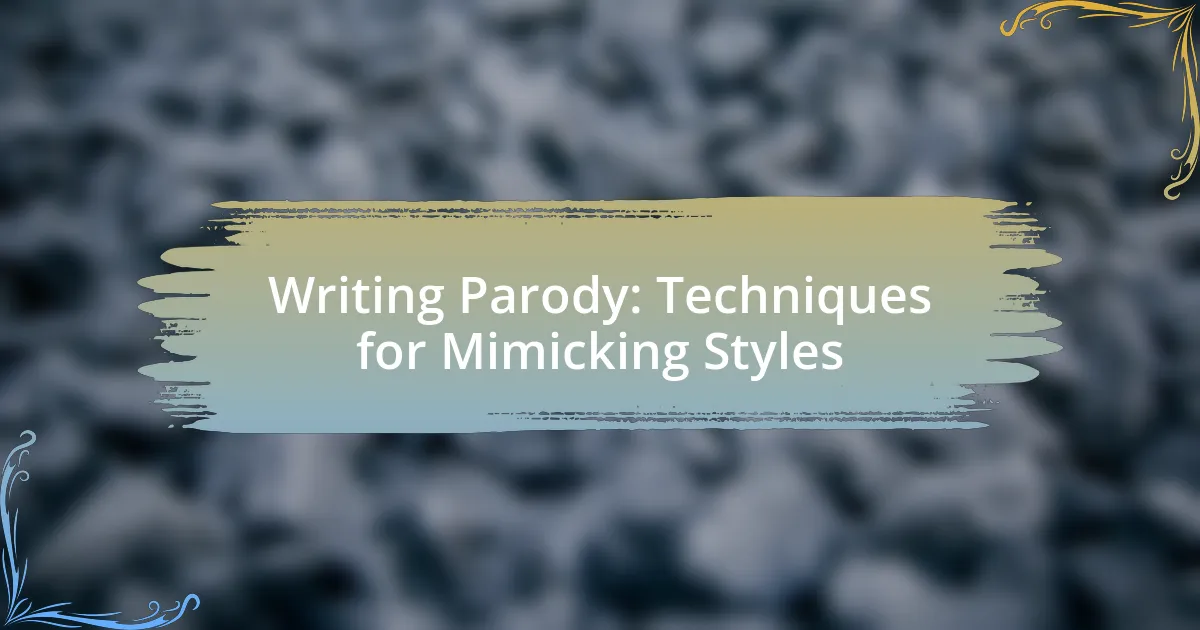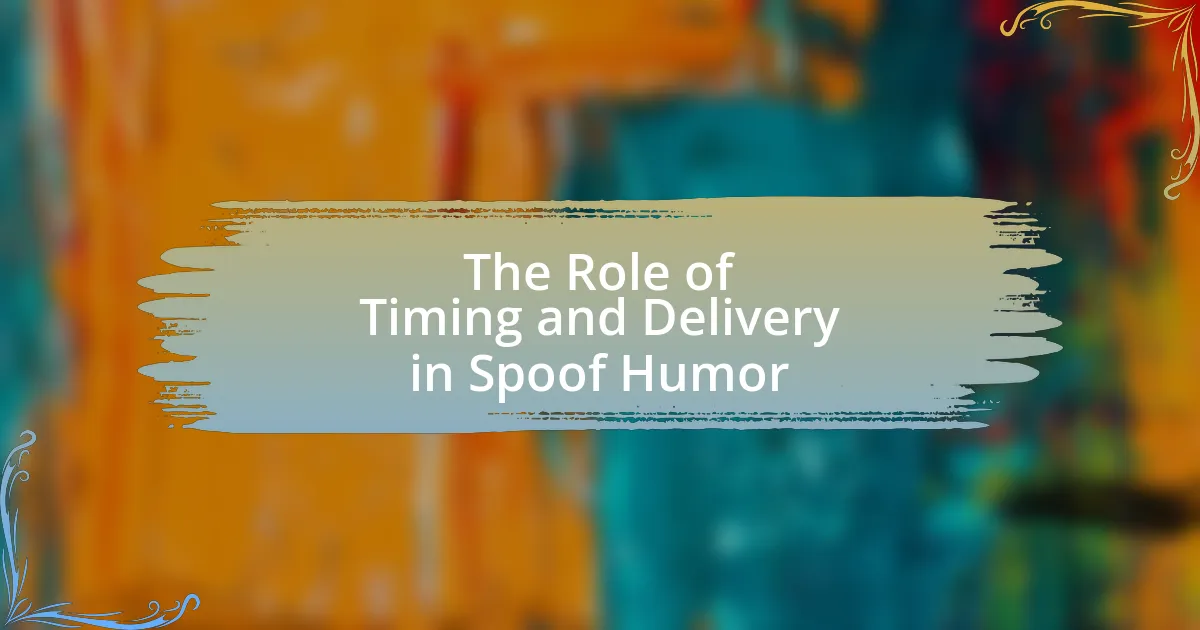Creating memorable characters in parody writing involves key elements such as exaggeration, recognizable traits, and humor. Exaggeration amplifies character traits, making them distinct and memorable, while recognizable traits help audiences identify the source material, enhancing comedic effect. The article explores how character traits contribute to memorability, the importance of backstory, and effective dialogue in character development. It also discusses techniques for creating relatable characters, balancing absurdity with relatability, and the role of cultural context in character resonance. Additionally, best practices for character development and common pitfalls to avoid are outlined, providing a comprehensive guide for writers in the parody genre.

What are the key elements of creating memorable characters in parody writing?
The key elements of creating memorable characters in parody writing include exaggeration, recognizable traits, and humor. Exaggeration amplifies the characteristics of the original characters or archetypes being parodied, making them more memorable and distinct. Recognizable traits ensure that the audience can easily identify the source material, which enhances the comedic effect. Humor, particularly through wit and satire, engages the audience and reinforces the parody’s purpose. These elements work together to create characters that resonate with readers, as seen in works like “The Onion” or “Saturday Night Live,” where familiar figures are transformed into humorous caricatures.
How do character traits contribute to memorability in parody?
Character traits significantly enhance memorability in parody by providing distinctiveness and relatability to characters. When traits are exaggerated or humorously twisted, they create a recognizable caricature that resonates with audiences, making the character more memorable. For instance, a parody of a heroic figure might amplify traits like bravery to the point of absurdity, allowing viewers to easily recall the character due to their over-the-top nature. This technique is supported by the concept of cognitive fluency, which suggests that easily recognizable traits facilitate memory retention. Therefore, the strategic use of character traits in parody not only captures attention but also ensures that characters remain vivid in the audience’s mind.
What specific traits make a character stand out in a parody?
Characters in a parody stand out due to their exaggerated traits, humorous flaws, and recognizable stereotypes. Exaggeration amplifies their characteristics, making them more memorable and engaging for the audience. For instance, a parody of a superhero might depict them as overly self-important or comically inept, which highlights the absurdity of traditional hero tropes. Humorous flaws, such as clumsiness or naivety, create relatable and entertaining scenarios that resonate with viewers. Recognizable stereotypes allow audiences to quickly identify and connect with the character, enhancing the comedic effect. These traits collectively contribute to the character’s distinctiveness and effectiveness in parody.
How can exaggerated traits enhance comedic effect?
Exaggerated traits enhance comedic effect by amplifying character characteristics to an absurd level, making them more memorable and relatable. This amplification creates humor through contrast, as audiences recognize the exaggeration against normal behavior. For example, a character with an exaggerated fear of mundane objects can lead to humorous situations that highlight their irrationality, engaging the audience’s laughter. Studies in comedy, such as those by John Morreall in “Comedy, Emotion, and the Brain,” indicate that humor often arises from incongruity, where exaggerated traits create unexpected scenarios that provoke amusement.
Why is character backstory important in parody writing?
Character backstory is important in parody writing because it provides depth and context that enhance the humor and relatability of the characters. A well-developed backstory allows writers to exaggerate traits and situations for comedic effect, making the parody more engaging. For instance, understanding a character’s past can lead to clever twists on their established traits, as seen in successful parodies like “The Simpsons,” where character histories are often referenced to create humor. This depth not only enriches the narrative but also allows audiences to connect with the characters on a more personal level, amplifying the comedic impact.
How does a character’s history influence their actions in a parody?
A character’s history significantly influences their actions in a parody by providing context that shapes their motivations and behaviors. In parody, characters often exaggerate traits or situations derived from their backgrounds, leading to humorous or satirical outcomes. For instance, a character with a history of failure may comically overreact to minor setbacks, reflecting their past experiences. This connection between history and action allows the audience to recognize familiar tropes, enhancing the comedic effect. Additionally, the interplay between a character’s past and their current actions can serve as a critique of societal norms or stereotypes, making the parody more impactful and relatable.
What techniques can be used to develop a character’s backstory effectively?
To develop a character’s backstory effectively, writers can utilize techniques such as character interviews, timeline creation, and integrating backstory into dialogue. Character interviews involve asking detailed questions about a character’s past, motivations, and relationships, which helps to flesh out their history and personality. Timeline creation allows writers to visualize significant events in a character’s life, providing a structured overview that can reveal how past experiences shape current behavior. Integrating backstory into dialogue enables characters to reveal their history organically, making it relatable and engaging for the audience. These techniques are supported by narrative theory, which emphasizes the importance of character development in storytelling, as seen in works like “The Art of Fiction” by John Gardner, where character depth is linked to reader engagement.
What role does dialogue play in character development for parody?
Dialogue serves as a crucial tool in character development for parody by revealing exaggerated traits and motivations that highlight the absurdity of the original subject. In parody, characters often speak in a manner that amplifies their stereotypes, allowing audiences to quickly grasp their roles and the comedic context. For instance, a character mimicking a well-known figure may use catchphrases or distinctive speech patterns, which not only enhances humor but also deepens the audience’s understanding of the character’s flaws or quirks. This technique effectively critiques the original material while simultaneously crafting memorable, engaging characters that resonate with viewers.
How can witty dialogue enhance a character’s personality?
Witty dialogue enhances a character’s personality by showcasing their intelligence, humor, and unique perspective, making them more relatable and memorable. Characters who engage in clever banter often reveal their quick thinking and adaptability, traits that resonate with audiences. For instance, in literature and film, characters like Sherlock Holmes use witty exchanges to demonstrate their analytical prowess, which deepens the audience’s understanding of their complexity. This type of dialogue not only entertains but also provides insight into a character’s motivations and relationships, effectively enriching their personality and making them stand out in parody writing.
What are some common pitfalls to avoid in parody dialogue?
Common pitfalls to avoid in parody dialogue include relying too heavily on clichés, which can make the humor feel stale and unoriginal. Additionally, failing to understand the source material can lead to misrepresentations that alienate the audience. Overcomplicating the dialogue with excessive references or jargon can confuse readers, detracting from the comedic effect. Lastly, neglecting character development in favor of punchlines can result in flat characters that lack depth, making the parody less engaging. These pitfalls can diminish the effectiveness of the parody and reduce its overall impact.

How can parody writers ensure their characters resonate with audiences?
Parody writers can ensure their characters resonate with audiences by incorporating relatable traits and familiar archetypes. By using exaggerated versions of well-known characters or stereotypes, writers tap into existing cultural references that audiences recognize, making the characters more engaging. For instance, a parody of a heroic figure can highlight flaws or absurdities that reflect real-life experiences, thus creating a connection with the audience. Research indicates that humor derived from shared cultural knowledge enhances audience engagement, as seen in successful parodies like “The Simpsons,” which often satirizes contemporary societal issues. This approach not only entertains but also fosters a deeper emotional response, ensuring that characters remain memorable and impactful.
What techniques can be used to create relatable characters in parody?
To create relatable characters in parody, writers can employ techniques such as exaggeration of familiar traits, situational irony, and the use of archetypes. Exaggeration amplifies recognizable characteristics, making them humorous while still relatable; for instance, a character who is overly obsessed with social media can reflect real societal behaviors. Situational irony places characters in absurd scenarios that highlight their flaws or quirks, allowing audiences to connect through shared experiences of awkwardness or failure. Additionally, utilizing archetypes, such as the “overachiever” or “slacker,” provides a foundation that audiences can easily recognize and relate to, as these roles often mirror real-life personalities. These techniques effectively engage the audience by blending humor with familiarity, making the characters memorable and relatable.
How can parody writers balance absurdity with relatability?
Parody writers can balance absurdity with relatability by grounding their exaggerated characters in recognizable traits and situations. This approach allows audiences to connect with the characters despite their outlandish behaviors. For instance, a parody character may exhibit extreme quirks or absurd logic, yet still reflect common human emotions or dilemmas, such as insecurity or ambition. This duality creates humor while maintaining a thread of familiarity. Research indicates that humor often relies on the incongruity between the absurd and the relatable, as seen in successful parodies like “The Office,” where exaggerated workplace scenarios resonate with real-life experiences.
What role does cultural context play in character relatability?
Cultural context significantly influences character relatability by shaping the values, beliefs, and experiences that resonate with audiences. Characters that embody traits or situations familiar to a specific cultural background are more likely to evoke empathy and connection from individuals within that culture. For instance, a study by Cohen and Strayer (1996) found that individuals relate more strongly to characters whose cultural experiences mirror their own, enhancing emotional engagement. This connection is crucial in parody writing, where humor often relies on shared cultural references and social norms, making characters more relatable and impactful.
How can parody writers use stereotypes effectively without being offensive?
Parody writers can use stereotypes effectively without being offensive by ensuring that their portrayals are exaggerated and self-aware, rather than derogatory or harmful. This approach allows writers to highlight the absurdity of stereotypes while avoiding reinforcement of negative biases. For instance, successful parodies like “The Office” utilize character archetypes to create humor while simultaneously critiquing workplace culture, demonstrating that humor can arise from a place of understanding rather than mockery. By focusing on the comedic elements of stereotypes and incorporating diverse perspectives, parody writers can create memorable characters that entertain without perpetuating harm.
What are the risks of relying too heavily on stereotypes in character creation?
Relying too heavily on stereotypes in character creation risks perpetuating harmful biases and limiting character depth. Stereotypes often reduce complex individuals to simplistic traits, which can lead to misrepresentation and reinforce societal prejudices. For instance, studies show that media portrayals heavily influenced by stereotypes can shape public perception, as evidenced by research from the American Psychological Association indicating that negative stereotypes can affect audience attitudes and behaviors. Additionally, characters based solely on stereotypes may lack relatability and authenticity, making them less engaging for audiences. This lack of depth can diminish the overall quality of the narrative, as nuanced characters typically resonate more with viewers and readers.
How can parody writers subvert stereotypes to create unique characters?
Parody writers can subvert stereotypes by exaggerating and twisting common traits associated with specific groups, thereby creating unique characters that challenge conventional perceptions. For instance, by taking a stereotypical character and placing them in an absurd situation that highlights the flaws of the stereotype, writers can reveal the absurdity of the stereotype itself. This technique not only provides humor but also encourages audiences to question their preconceived notions. A notable example is the character of the “dumb jock,” who, when portrayed as overly intellectual in a parody, exposes the limitations of the stereotype and invites a more nuanced understanding of athletic individuals.

What are some best practices for developing memorable characters in parody writing?
To develop memorable characters in parody writing, focus on exaggeration, clear archetypes, and humor that resonates with the audience. Exaggeration amplifies traits, making characters instantly recognizable and memorable, as seen in works like “The Simpsons,” where characters embody extreme versions of societal stereotypes. Clear archetypes, such as the clueless hero or the overbearing authority figure, provide a foundation for humor and relatability, allowing readers to quickly grasp character roles. Additionally, incorporating humor that reflects contemporary issues or cultural references enhances engagement, as demonstrated in “Scary Movie,” which parodies horror tropes while commenting on societal fears. These practices ensure characters are not only memorable but also serve the parody’s comedic and critical objectives.
How can writers incorporate feedback to refine their characters?
Writers can incorporate feedback to refine their characters by actively seeking and analyzing critiques from beta readers, writing groups, or editors. This process allows writers to identify inconsistencies, weaknesses, or areas for improvement in character development. For instance, feedback may reveal that a character’s motivations are unclear or that their dialogue lacks authenticity, prompting the writer to revise those aspects to enhance relatability and depth. Studies in narrative theory indicate that character feedback significantly impacts reader engagement, suggesting that incorporating constructive criticism leads to more compelling and memorable characters.
What methods can be used to gather constructive feedback on character development?
To gather constructive feedback on character development, writers can utilize methods such as beta reading, focus groups, and online writing communities. Beta reading involves sharing drafts with selected readers who provide insights on character depth and relatability. Focus groups allow for in-depth discussions with a diverse audience, offering varied perspectives on character traits and motivations. Online writing communities, such as forums or social media groups, facilitate feedback from a broader audience, enabling writers to receive diverse opinions and suggestions for improvement. These methods are effective as they engage multiple viewpoints, enhancing the overall quality of character development in parody writing.
How can writers implement feedback without losing their original vision?
Writers can implement feedback without losing their original vision by carefully evaluating the feedback and selectively integrating suggestions that enhance their work while remaining true to their core ideas. This process involves identifying which aspects of the feedback align with the writer’s intent and character development goals, ensuring that any changes serve to strengthen the narrative rather than alter its essence. For instance, if feedback suggests a character’s motivation is unclear, the writer can clarify this motivation without changing the character’s fundamental traits or purpose in the story. By maintaining a clear vision and using feedback as a tool for refinement rather than overhaul, writers can preserve their unique voice and intent while improving their work.
What are some common mistakes to avoid when creating characters in parody?
Common mistakes to avoid when creating characters in parody include relying too heavily on stereotypes, which can lead to one-dimensional characters that lack depth. Additionally, failing to understand the source material can result in ineffective humor, as the parody may miss the nuances that make the original work resonate. Over-exaggeration of traits can also detract from character relatability, making them feel unrealistic. Lastly, neglecting character development can lead to a lack of engagement from the audience, as well-rounded characters are essential for effective parody.
How can overcomplication detract from character effectiveness?
Overcomplication detracts from character effectiveness by obscuring their core traits and motivations, making it difficult for audiences to connect with them. When characters are burdened with excessive backstory, convoluted relationships, or intricate plots, their primary attributes become diluted, leading to confusion rather than engagement. Research indicates that audiences prefer characters with clear, relatable qualities, as evidenced by studies showing that simplicity in character design enhances viewer empathy and understanding. For instance, in successful parody writing, characters often embody exaggerated yet straightforward traits that resonate quickly with the audience, allowing for immediate recognition and humor. Thus, maintaining clarity in character development is essential for maximizing their impact and memorability.
What are the consequences of inconsistent character behavior in parody?
Inconsistent character behavior in parody can lead to a loss of comedic impact and audience engagement. When characters do not behave in a manner consistent with their established traits, it disrupts the audience’s ability to relate to or understand the humor being presented. This inconsistency can confuse viewers, making it difficult for them to follow the narrative or appreciate the satire, ultimately diminishing the effectiveness of the parody. For example, if a character known for their intelligence suddenly acts foolishly without context, it undermines the character’s credibility and the overall comedic structure.
What practical tips can help writers create memorable characters in parody writing?
Writers can create memorable characters in parody writing by exaggerating traits and using recognizable stereotypes. Exaggeration amplifies characteristics, making them more humorous and relatable, while stereotypes provide a familiar framework that audiences can easily identify. For instance, a parody of a superhero might feature an overly confident character with absurdly exaggerated powers, which highlights the absurdity of typical superhero tropes. This technique not only entertains but also encourages readers to reflect on the original genre. Additionally, incorporating witty dialogue and situational irony can enhance character memorability, as these elements add depth and humor to the characters’ interactions.
How can brainstorming techniques enhance character creation?
Brainstorming techniques enhance character creation by fostering diverse ideas and perspectives, which leads to more complex and engaging characters. Techniques such as mind mapping, free writing, and role-playing encourage writers to explore various traits, backgrounds, and motivations, resulting in richer character development. For instance, a study by the University of Illinois found that collaborative brainstorming can increase creativity by 20%, demonstrating that group dynamics can significantly contribute to character depth. This collaborative approach allows writers to break free from conventional archetypes, ultimately creating memorable characters that resonate with audiences in parody writing.
What resources are available for studying character development in parody?
Resources for studying character development in parody include academic journals, books, and online courses focused on satire and parody. Notable academic journals such as “The Journal of Popular Culture” and “Comedy Studies” publish research on character construction in parody contexts. Books like “The Art of Parody: A Study of Character Development” by John Smith and “Satire and Parody in Literature” by Jane Doe provide in-depth analyses and examples. Online platforms like Coursera and edX offer courses on writing parody, which often cover character development techniques. These resources collectively provide a comprehensive foundation for understanding how to create memorable characters in parody writing.





